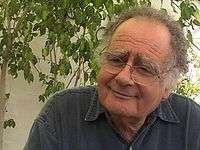Micha Ullman
Micha Ullman (Hebrew: מיכה אולמן, born 1939) is an Israeli sculptor and professor of art.

Biography
Micha Ullman was born in Tel Aviv to German Jews who immigrated to Mandate Palestine in 1933.[1] As a teenager, he attended the Kfar HaYarok agricultural school.[2] In 1960-1964, he studied at Bezalel Academy of Art and Design in Jerusalem. In 1965, he attended the Central School of Arts and Crafts in London, where he learned etching.[2]
Ullman is married to Mira, and lives in Ramat Hasharon, Israel.[2]
Academic career
He taught at Bezalel Academy in 1970 - 1978. He became a visiting professor at Academy of Arts Düsseldorf in 1976. He taught at the University of Haifa from 1979 - 1989. He was appointed Professor of Sculpture at the State Academy of Fine Arts in Stuttgart in 1991.[3]
Artistic career
Ullman created the underground “Bibliotek” memorial on Bebelplatz square in Berlin, where the Nazi book burnings began in 1933. The memorial consists of a window on the surface of the plaza, under which vacant bookshelves are lit and visible. A bronze plaque bears a quote by Heinrich Heine: “Where books are burned in the end people will burn.”[4] This memorial was inaugurated in May 1995.[5] (see book burning). Ullman explains: "It begins with the void that exists in every pit and will not disappear. You could say that emptiness is a state, a situation formed by the sides of the pit: The deeper it is, the more sky there will be and the greater the void. In the library containing the missing books, that void is more palpable. We expect [the books] but they are not there."[2]
In 1997, Ullman completed a synagogue memorial in collaboration with Zvi Hecker and Eyal Weizmann, commemorating the former Lindenstraße synagogue in Kreuzberg.[6]
Another of his creations is "Hochwasser" ("Flooding") on a small island near the Werra River in Germany. It was inspired by a boat Ullman saw there with a sign on it stating it had a capacity of up to seven passengers. Ullman's father, Yitzhak, who had lived nearby, immigrated to Palestine with his seven siblings in 1933.[2]
Sculptural style
Ullman creates subterranean sculptures, some of which barely protrude from the ground. They touch on universal themes such as the meaning of place and home, absence and emptiness. They have been described as simultaneously "celestial and earthbound, metaphysical but sensual and tactile.[1]
Gallery
- Ground, 1987
Marl, Germany - Havdalah, 1988
iron and gravel
Tefen Open Museum, Israel  Yesod, 1989
Yesod, 1989
concrete and sand
Rothschild Boulevard, Tel Aviv-Yaffo, Israel
 Memorial for the book burning, 1995
Memorial for the book burning, 1995
Berlin, Germany
- Pillar, 1995
Iron 
Education
- 1960-1964 Bezalel Academy of Arts and Design Academy, Jerusalem
- 1965 Central School of Arts and Crafts, London
Teaching
- 1970-1978 Bezalel Academy of Arts and Design, drawing, basic design and etching
- 1976 Guest lecturer at Fine Arts Academy, Düsseldorf
- 1979 Haifa University, basic design, drawing, three-dimensional design
- 1979-1985 Faculty of Architecture, Technion, Haifa
- 1991 Academy of Art, Stuttgart, sculpture
Awards
Ullman was awarded the Israel Prize for sculpture in April 2009.[1][7][8]
Awards and Prizes
- 1963 Sonborn Prize, Bezalel Academy of Arts and Design Academy of Arts & Design, Jerusalem
- 1972 The Beatrice S. Kolliner Award for a Young Israeli Artist, Israel Museum, Jerusalem, Jerusalem, Israel
- 1980 The Sandberg Prize for Israeli Art, Israel Museum, Jerusalem, Israel
- 1985 Mendel Pundik Prize, Tel Aviv Museum
- 1989 Annual Scholarship, DAAD, Berlin
- 1995 Käthe Kollwitz Prize, Academy of Arts, Berlin
- 1996 Zussman Prize, Yad Vashem
- 1996 Member of the Academy of Arts, Berlin
- 1997 - פרס החברה לתרבות ולשלום בינלאומי, עמאן, ירדן.
- 1998 Janet and George Jarin Prize, America Israel Cultural Foundation
- 2000 Gamzu Prize and Aftovitzer Fund, Tel Aviv Museum of Art, Tel Aviv
- 2004 Awarded Honorary Ph.D, The Hebrew University, Jerusalem
- 2005 Hans-Thoma-Preis, Staatspreis des Landes Baden - Wurttemberg, Germany
- 2009 Israel Prize for Sculpture
- 2010 Gerhard- Altenbourg-Preis, Lindenau Museum Altenburg
- 2011 Moses-Mendelssohn-Preis des Landes Berlin, Germany
Outdoor and Public Art
- 1983 Sky, limestone, Tel Hai, Israel
- 1984 Ben Hinnom Valley, iron and cable, Jerusalem
- 1984 Lot's Wife, earth, Mt. Sodom, Israel
- 1989 Jesod (Foundation), cement and sand, Rothschild Boulevard, Tel Aviv
- 1991 Schodnia (East), asphalt, Lodz, Poland
- 1992 Sea Level, cast iron, sandstone and glass, 22 Allenby St., Tel Aviv
- 1992 Niemand, corten steel and red loam, Gropius Bau, Berlin, Germany
- 1995 Bibliothek, cement and glass, Bebelplatz, Berlin, Germany
- 1996-1997 Water, Zion Square, West Jerusalem and Freres Street, East Jerusalem
See also
- List of Israel Prize recipients
- Dorit Kedar, "A fine balance: Michael Gross and Micha Ulman" In Art In Israel Autumn 1989, Vol. 1, Number 3, Pg. 28-31.
References
| Wikimedia Commons has media related to Micha Ullman. |
- 1 2 3 Michal Lando. Art that hints at big questions, The Forward. April 22, 2009
- 1 2 3 4 5 The Accidental Sculptor, Haaretz
- ↑ Galerie Cora Hölzl. Micha Ullman, Retrieved 13 May 2009.
- ↑ Edward Rothstein. In Berlin, Teaching Germany’s Jewish History, The New York Times, May 1, 2009
- ↑ Jennifer A. Jordan. Structures of memory: understanding urban change in Berlin and beyond, Stanford University Press, 2006. P. 103. ISBN 0-8047-5277-X
- ↑ Jordan, p. 149
- ↑ "Israel Prize Official Site (in Hebrew) - Recipient's C.V.".
- ↑ "Israel Prize Official Site (in Hebrew) - Judges' Rationale for Grant to Recipient".
External links
- Micha Ullman collection at the Israel Museum. Retrieved January 22, 2012
- "Micha Ullman". Information Center for Israeli Art. Israel Museum. Retrieved January 22, 2012.
- Art of Micha Ullman at Europeana. Retrieved January 22, 2012
- Official site of Staatliche Akademie der Bildenden Künste